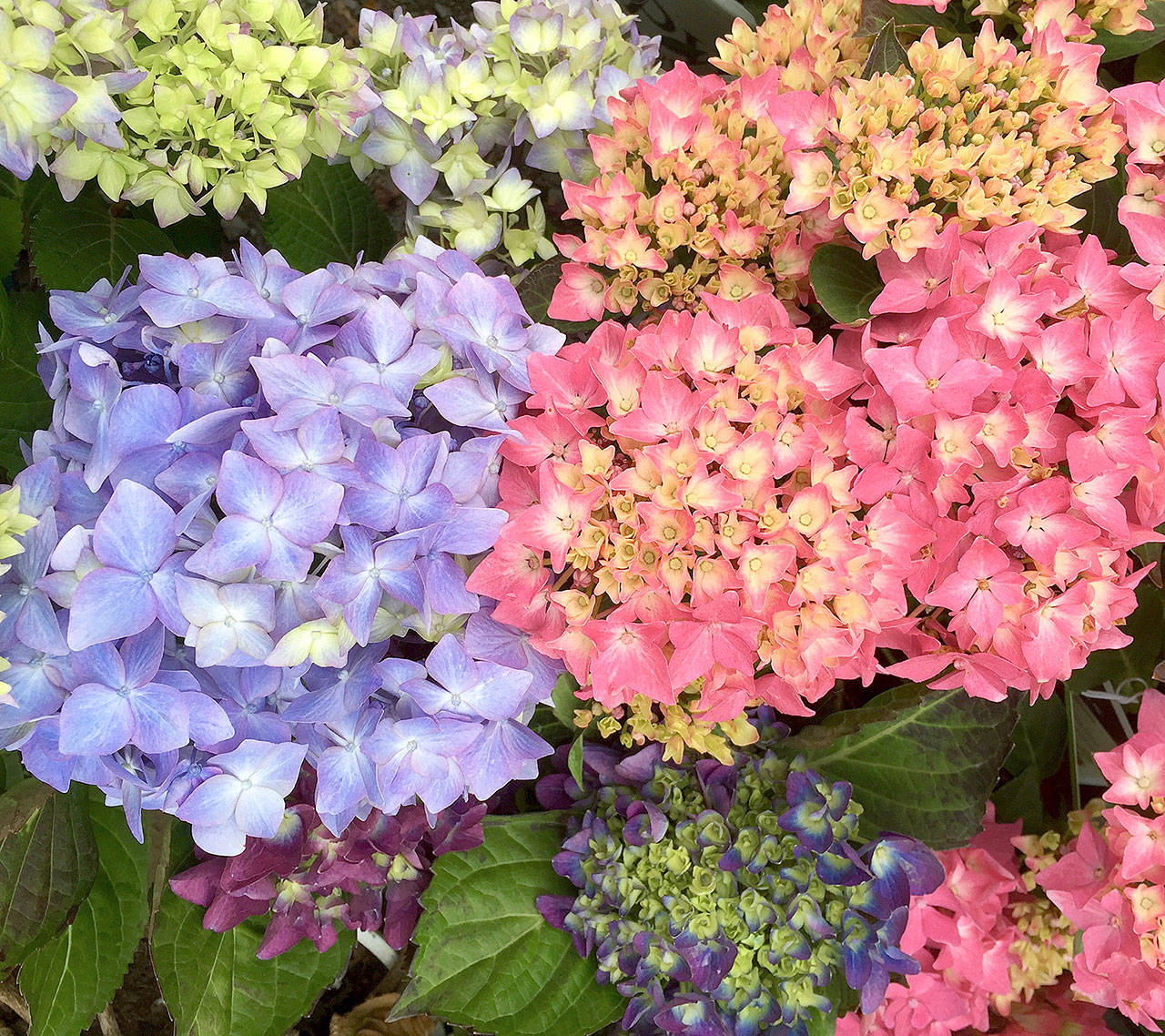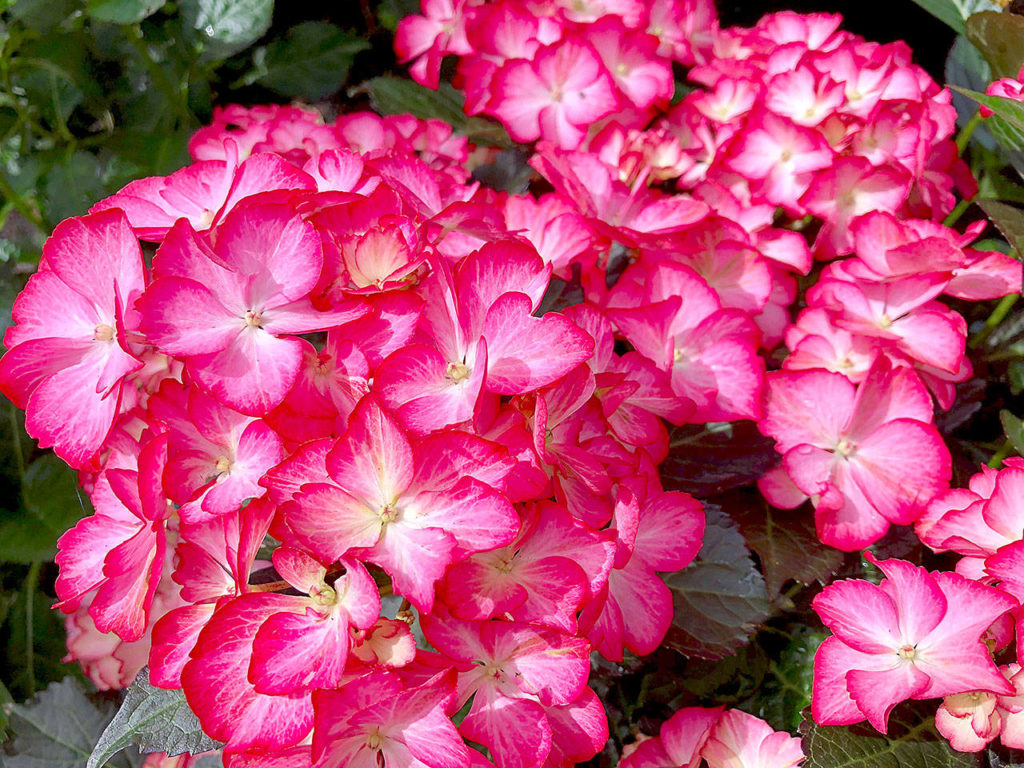Everybody loves hydrangeas. After the cacophony of spring has passed, and all the rhodies and azaleas are out of bloom, hydrangeas pick up the baton and continue with the parade of color in our gardens.
They come in blues, purples, reds, pinks, and even white. They can have large “mop heads” or delicate “lace caps.” Some varieties grow best in sun, others prefer shade, and there are even a few vining varieties that will clamber up a wall or tree trunk.
I have over 12 different varieties in my garden alone. Despite all these wonderful attributes, I hear the same two complaints about hydrangeas every year in the garden center: “My hydrangea won’t bloom” and “My hydrangea gets too big.”
I am happy to report that those two issues have been solved with the new Bailey Nurseries’ Endless Summer and Monrovia’s Seaside Serenade series. The Endless Summer collection features reblooming hydrangeas; the Seaside Serenade collection, compact shrubs.
Traditionally, most big-leafed hydrangeas bloom only on last year’s wood — so if the plant is either pruned too severely in the winter or Mother Nature freezes it to the ground, there will be no blooms for the coming season. About 14 years ago, in Minnesota nursery, a hydrangea was discovered that was blooming on both last year’s wood and current season’s wood.
Thus, the Endless Summer hydrangea brand was born. You have probably seen them everywhere that plants are sold. They come in a blue pot — about the same color as the flowers — and make a fantastic garden plant.
Since the Original, the first of the hydrangea varieties in the collection, three more versions have found their way to the market, and a fourth is due out next spring (although I am hoping to snag one this fall). If you go to the Endless Summer website you can learn all about them. Just be careful that you don’t start drooling all over your keyboard.
The other common complaint about hydrangeas concerns their ultimate size. Most of the older varieties topped out at 5- to 6-feet tall and wide. If you had to chop them back to fit into a space, then you lost the blooms. The new “Summer Crush” hydrangea from the Endless Summer brand will grow only 18- to 36-inches tall, so it will fit nicely into a lot of our smaller yards. And like all of the varieties in this series, it will bloom all summer.
The other new series of hydrangeas — the flowers are absolutely drop-dead gorgeous — are from Monrovia Growers and are called the Seaside Serenade series. These incredible plants sport dark-bronze foliage and bicolored flowers, so they really stand out in the garden.
The names are all inspired by the East Coast, like “Bar Harbor,” “Hamptons” and “Cape Cod,” which is a bit of a put-off for us Northwesterners but, what the heck, the plants are fabulous, so I guess we can overlook a silly little name. Be sure you check out “Fire Island,” with its ruffled flowers that are white and edged with red; they are amazing to say the least. All of the Seaside Serenade series appear to stay in the 3- to 4-foot range so again, they will fit well into our smaller gardens. For further research, check out the Monrovia website.
Probably 85 percent of all the hydrangeas on the market now are of the reblooming habit (it will say that on the plant tag), and most of them will stay in the 3-foot range, so gardeners have lots of options. In fact, you may find your head spinning in the garden center, where you could be looking at as many as 30 to 40 different choices. July is high-blooming season for hydrangeas, so it’s a perfect time to make your summer visit back to the nursery. (You’ll also see lots of plants besides hydrangeas that weren’t available back in April and May.)
As for growing big-leaf hydrangeas, it’s pretty easy. They do best in morning sun with afternoon shade and prefer a consistently moist soil. Those big leaves will wilt rapidly if they get too dry. Too much shade, like on the north side, can sometimes result in “leggy” plants that bloom sparingly if at all.
Cutting a third of the old growth every year will keep them looking healthy and tidy. Finally, if you want to manipulate the colors from pink to blue (and everything in between), you can add potassium nitrate to your soil for pink or aluminum sulfate for blue. Both of these chemicals can be found at your local garden center.
There you go. You have no more reason to whine about hydrangeas that don’t bloom or get too big. You now have lots of options to choose from.
Steve Smith is the owner of Sunnyside Nursery in Marysville and can be reached at info@sunnysidenursery.net.
Prune with confidence
Attend a free summer pruning class that will give you the knowledge and confidence you’ve been looking for at 10 a.m. July 7 or 11 a.m. July 8 at Sunnyside Nursery, 3915 Sunnyside Blvd., Marysville. For more information or to sign up, visit www.sunnysidenursery.net.
Talk to us
> Give us your news tips.
> Send us a letter to the editor.
> More Herald contact information.



























